The Story of PFC Armando Achino
- By Mauro Mazzia -
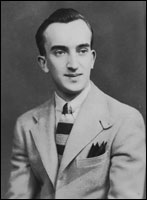
Armando Dante Achino
1920 - 1944
Francesco and Giuseppina Achino were born and raised in Masserano, Italy, in the Achino area from which their surname originated. Shortly after they were married in the beginning of 1920, Francesco decided to leave Italy to go to the USA. Giuseppina was with child, so she decided to stay in Masserano. She gave birth to Armando Dante Achino on 9 August 1920. Mother and son lived together in their little village for about eight months, far away from the father. The only tangible proof of their brief life together in Italy is an extraordinary picture showing five generations: great-great grandmother, great grandmother, grandfather, mother and son.
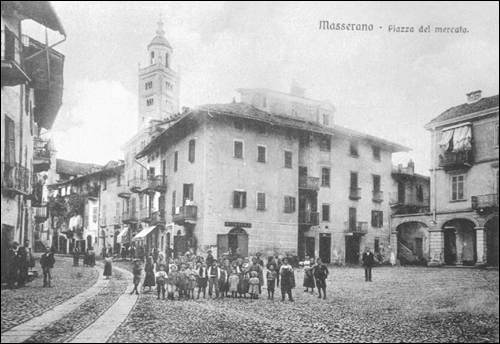
The marketplace in Masserano around 1920,
the year Armando Achino was born there.
In the spring of 1921, Giuseppina decided to join her husband in New York City. Her father took her and her little child to the railway station in Gattinara. Giuseppina felt very much alone as she faced this long and exhausting journey, responsible for the baby and their luggage. They traveled first by train, and then by ship. After two weeks they passed the Statue of Liberty, and finally they met Francesco in New York. They went to live in Manhattan, at 328 West 44th Street, among hundreds of other Italian immigrants. Among them, of course, were many people from Biella.

Scenes of immigrant ships in the 1920's. The ships were old and filthy, the decks
were crowded, and the living conditions were deplorable. This is what Giuseppina
endured as she brought young Armando to New York in search of a better life.
Together again, Francesco got a job as a cook, and Giuseppina became a factory worker. After getting jobs, they became American citizens and changed their names to Frank and Josephine. However, Armando and his sisters Olga and Nilda (who were born after Armando) kept their Italian names.
Armando grew up just like many other Italian-American children in New York City, although few details are known about his childhood. All that exist are just a few vague recollections of Fulda Samarati, who emigrated from Masserano to the USA in 1930 when she was 7 years old. She recalled a trip that she and Armando took with some friends when they were pre-teens in the mid 1930’s. They crossed the Hudson River on the George Washington Bridge and went to New Jersey, which at the time was mostly grass and woods. She also spoke about a room rented by Armando and some other friends on 42nd Street in New York, where their youth group called The Flames shared each other’s company and listened to music. Thanks to Fulda, we can draw a brief portrait of Armando: he was not a tall or a handsome man, but he was really sweet and kind.
Years passed by, and history was taking her course. After suffering the Pearl Harbor attack in December of 1941, the USA entered the Second World War against the Axis Coalition. Armando was called to arms, as were many other American young men. He was sent to the 752nd Tank Battalion, where he trained as a private at Fort Lewis WA, and then in the Mojave Desert in California. On 6 August 1942, Armando and his battalion left New York for Liverpool, England. After several more months of training, they were sent to North Africa, where they landed on January 7, 1943. Because of bureaucratic mistakes, the 752nd Tank Battalion was inactivated for several months, and they did not engage in combat.
In January 1944, the battalion was re-organized and sent to Italy. They arrived in Italy on the 12th of January, landing at the port of Bagnoli, near Naples. They were assigned to more training in the Eboli area. Finally, Armando was back in his native country. We know that he hoped to have the opportunity to come back to Masserano at the end of the war, to see grandparents, aunts, uncles and cousins; all the relatives he had never met before.
Armando was assigned to the Medical Detachment of the 752nd Tank Battalion. He was a combat medic, part of a five man crew of a halftrack ambulance. His job was to follow the battalion into combat and administer first aid to injured soldiers. It was a difficult and unpleasant task. Most of the time they were under enemy fire, yet they were unarmed. They were all very brave men.

Halftrack ambulances, similar to that of PFC Armando Achino. These
ambulances provided mobility over rough terrain, and provided some
protection for the casualty and the medics against small arms fire.
The 752nd Tank Battalion received its baptism of fire on 27 May 1944, near Roccagorga and Maenza, two small villages in the middle of the Lazio region. This area was being crossed by the Allies, who were heading straight for Rome, which was liberated a few days later. Unfortunately, Armando never made it to Rome.
It was 2 AM on 4 June 1944. The 752nd Tank Battalion was moving in a column on Highway 6 toward Rome, near Osteria Finocchio e Centocelle. They were practically at the gates of the town, when a German ME 109 fighter attacked it with bombs. One of the bombs scored a direct hit on the ambulance, instantly killing Armando and his fellow medic Ernest S. Wittwer. Three other medics were seriously injured in the blast. Just a few hours later, the Allies triumphantly entered Rome and were welcomed as liberators.
Armando was buried in the American military cemetery in Anzio-Nettuno, along with many other young comrades-in-arms. Frank and Josephine were shattered by the grief of having lost a son. They were even more shattered to think about him, lying so near but so far from his birthplace. At the end of the war, they started to take the necessary steps and negotiations to move Armando’s body from Anzio and bring it to Masserano. In 1948, Josephine went back to Italy to participate in the funeral rites for her child. Unfortunately, because of bureaucratic problems, she had to leave Italy before the rites took place. Armando's Uncle Remo and Aunt Laura waited at the graveyard for their nephew, and welcomed him at the end of his last journey, from Anzio to Masserano.
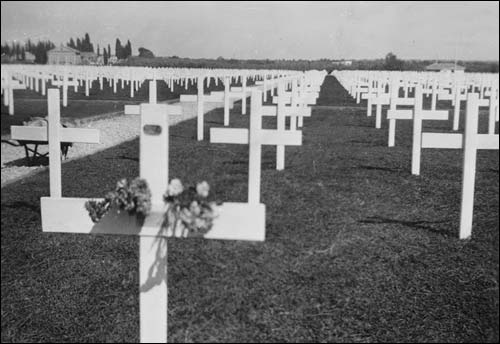
PFC Armando D. Achino's flower-adorned grave
at Anzio-Nettuno American Military Cemetery
(Now known as the Sicily-Rome American Cemetery)
It was 27 October 1948 when Armando’s flag-draped coffin arrived in Masserano. It was carried on an American Dodge military truck, with an escort of two officers. It was a solemn funeral, conducted during a light rain. Armando’s coffin was carried by the officers and some civilians, and was followed by the school children and a large crowd of citizens. At the end of the ceremony, Armando was laid to rest in the family grave, while one of the officers gave a speech about Armando’s personal deeds. The American flag was presented to Armando’s family.
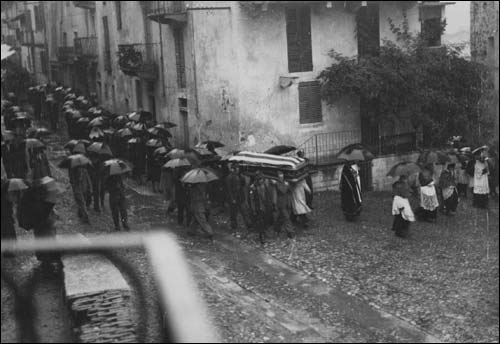
Armando Achino's funeral procession
Masserano, Italy, 27 October 1948
If you go to the Masserano churchyard today, you will easily find Armando’s grave. It is still adorned with fresh flowers. His picture on the tombstone is very, very old, but you can clearly read the English words:
New York
PFC Infantry
World War II
August 9, 1920
June 4, 1944
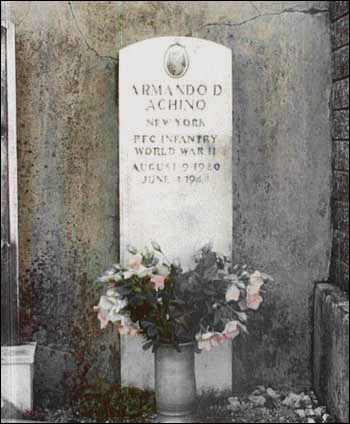
Armando Achino's flower-adorned grave
Masserano, Italy, 2004
Armando is lying in peace now. His life was just a circle. His journey ended where it had started, in the place where he was born. A place the man had never really known.
- Note From the Author -I would never have been able to write the story of Armando’s life, without the precious help of some people. My warmest thanks to you all:
Prof. Grazia Achino and her family for all the information and pictures regarding Armando, and for your generosity and the confidence their placed in me. My friend Gianpiero Achino for the initial information. Mrs. Fulda Samarati for the story she gave me as a precious gift. Alfonso and Marco Felici for their kind attention, advice, and precious help. A special thank you to my friend Ilaria Gariazzo. Department of the Army, U.S. Army Human Resources Command, Alexandria, VA, U.S.A. Robert J. Holt, 752nd Tank Battalion historian and webmaster (http://www.752tank.com) for his help, information, pictures, kind attention, and friendship. - Mauro Mazzia -
Originally published in “Rivista Biellese” Biella, Italy 2004
Web version adapted by Robert J. Holt, with permission
Page Content Copyright 2004 - 2025 Mauro Mazzia & Robert J. Holt
All Rights Reserved